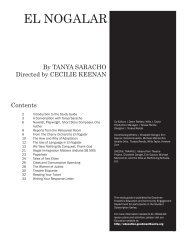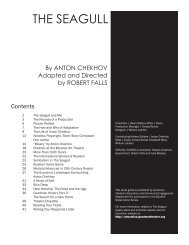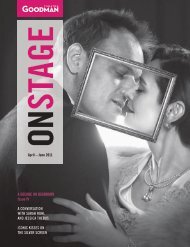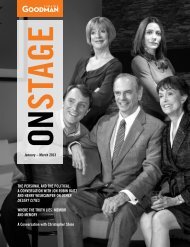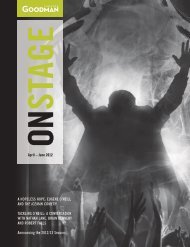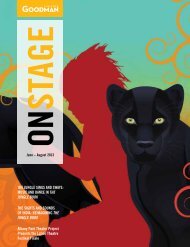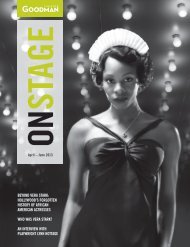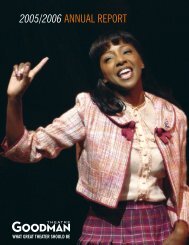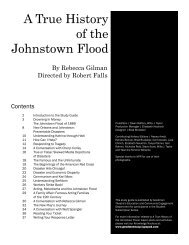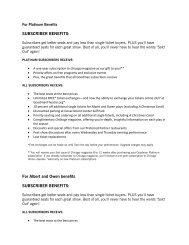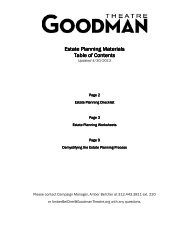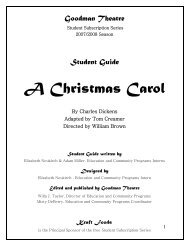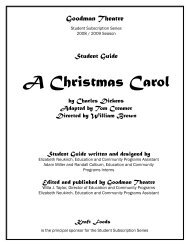Download - Goodman Theatre
Download - Goodman Theatre
Download - Goodman Theatre
You also want an ePaper? Increase the reach of your titles
YUMPU automatically turns print PDFs into web optimized ePapers that Google loves.
LEFT: Peg Murray and<br />
Scott Jaeck in <strong>Goodman</strong><br />
<strong>Theatre</strong>’s 1982 production<br />
of Tennessee<br />
Williams’ A House Not<br />
Meant to Stand. Photo<br />
by Lisa Ebright. BELOW:<br />
Tennessee Williams<br />
and <strong>Goodman</strong> <strong>Theatre</strong><br />
Executive Director Roche<br />
Schulfer outside the<br />
<strong>Goodman</strong> Studio.<br />
Tennessee and Chicago<br />
By Steve Scott<br />
Although the city most often associated<br />
with Tennessee Williams’ work was New<br />
Orleans (his adopted home and the setting<br />
of some of his most famous works), it was<br />
Chicago that gave him his first real success<br />
in the theater and that would provide<br />
artistic haven to him late in his career.<br />
Williams’ love affair with the Windy City<br />
began in 1944 with the landmark success<br />
of The Glass Menagerie, produced<br />
at the Civic <strong>Theatre</strong> prior to its arrival on<br />
Broadway. Claudia Cassidy, the venerated<br />
critic for the Chicago Tribune, became a<br />
passionate advocate for the play, writing<br />
in her initial review that, “it reaches out<br />
its tentacles, first tentative, then gripping,<br />
and you are caught in its spell.” Cassidy’s<br />
praise, and her continued exhortations<br />
to local audiences to support the play,<br />
brought national attention to the work<br />
before it had even moved to New York,<br />
and helped establish Williams as the preeminent<br />
dramatist of his generation.<br />
Thereafter, Williams considered Chicago<br />
to be one of the best theater towns in<br />
the world; in a 1951 letter to Cassidy,<br />
he urged her to stump for the establishment<br />
of a strong locally based theater<br />
community here, exclaiming, “No better<br />
place on Earth!” Touring productions<br />
of his Broadway hits were a staple in<br />
Chicago in the 1950s and 1960s, and,<br />
as local producing companies began to<br />
sprout, Williams’ plays were an important<br />
part of their repertoire. Director<br />
George Keathley’s first major hit at the<br />
old Ivanhoe <strong>Theatre</strong> was a much-lauded<br />
revival of The Rose Tattoo which swept<br />
the first annual Joseph Jefferson Awards<br />
in 1969. Two years later, Keathley produced<br />
the world premiere of Williams’<br />
Out Cry, an experience unfortunately<br />
marred by the playwright’s erratic behavior—although<br />
Williams later admitted,<br />
after the failure of a subsequent New<br />
York production with a different director,<br />
that the play “was better in Chicago.”<br />
Problems also plagued the 1980 premiere<br />
of Clothes for a Summer Hotel, which<br />
starred <strong>Goodman</strong> School of Drama alumna<br />
Geraldine Page as the ill-fated Zelda<br />
Fitzgerald; although Williams himself was<br />
in better emotional shape, his play was<br />
greeted with critical disappointment.<br />
Later that year, the playwright embarked<br />
on an alliance with <strong>Goodman</strong> <strong>Theatre</strong><br />
that would result in in his final major<br />
work for the stage. Some Problems for<br />
the Moose Lodge, which was produced<br />
first in the <strong>Goodman</strong> Studio as one of<br />
three short plays collectively billed as<br />
Tennessee Laughs<br />
(a title Williams<br />
apparently loathed),<br />
was a darkly savage<br />
comedy detailing<br />
the travails of<br />
Cornelius and Bella<br />
McCorkle, an elderly<br />
couple dealing with<br />
the disintegration<br />
of their family and<br />
their marriage. The<br />
reception of Moose<br />
Lodge was positive<br />
enough to encourage<br />
Williams to expand the play into a longer<br />
one-act, now entitled A House Not Meant<br />
to Stand, produced in 1981, again in the<br />
<strong>Goodman</strong> Studio. Despite some critical<br />
misgivings, Williams kept working on the<br />
play, encouraged by then-Artistic Director<br />
Gregory Mosher; the result was a fulllength<br />
version of House, which premiered<br />
on the <strong>Goodman</strong> mainstage in the spring<br />
of 1982. Now subtitled by the author<br />
“A Gothic Comedy,” the new version<br />
expanded the expressionistic absurdities<br />
of its earlier drafts, revealing even more<br />
passionately the playwright’s own frustrations<br />
with the challenges of aging; as<br />
Richard Christiansen noted in his Chicago<br />
Tribune review, “it is a loud, harsh, bitter<br />
pain-filled shriek at the degenerative process<br />
of life…a tantalizing and frustrating<br />
creation.” A House Not Meant to Stand<br />
would be the last production with which<br />
Williams himself would be associated;<br />
tragically, he died nine months later.<br />
7



